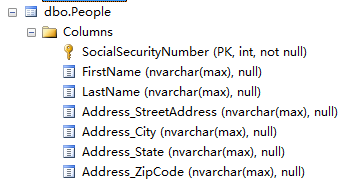Entity Framework创建实体映射表字段信息
- 创建一个新表并建立和实体的映射:
首先是定义实体:
public class Person {
[Key]
public int SocialSecurityNumber { get; set; }
public string FirstName { get; set; }
public string LastName { get; set; }
}
2. 创建实体的和数据库的中间层映射(映射存在于DbContext的子类):
public class BreakAwayContext : DbContext {
public DbSet<Person> Persons { get; set; }
…
}
3. 指定约束:
方式一:attribute方式,直接在字段上面添加约束;
public class Trip {
[Key, DatabaseGeneratedOption.Identity]
public Guid Identifier { get; set; }
}
方式二:在中间层以Fluent API方式指定(重写DbContext的OnModelCreating方法)
protected override void OnModelCreating(DbModelBuilder modelBuilder) {
modelBuilder.Entity<Trip>().HasKey(p => p.Identifier);
modelBuilder.Entity<Trip>().Property(p => p.Identifier).HasDatabaseGeneratedOption(DatabaseGeneratedOption.Identity);
}
方式三:如果配置非常多,放在OnModelCreating中会显得很臃肿,那么就封装成EntityTypeConfiguration的类:
public class TripConfig : EntityTypeConfiguration<Trip> {
public TripConfig() {
HasKey(p => p.Identifier);
Property(p => p.Identifier).HasDatabaseGeneratedOption(DatabaseGeneratedOption.Identity);
}
}
4.复杂类型
复杂类型仅仅是是为了实现应用层逻辑上面的一种封装,在数据库的表中依然是作为主表中的字段,而不是单独成表。
- 没有主键(如果有主键,那在生成的时候就会创建新表);
- 所有属性的字段必须是.net原生类型(Primitive Type);
- 不能是List,这能是单一实例。
public class Person {
public Person() {
this.Address = new Address();
}
…
public Address Address { get; set; }
}
public class Address {
public string StreetAddress { get; set; }
public string City { get; set; }
public string State { get; set; }
public string ZipCode { get; set; }
}
最终,形成的表结构如下所示:






